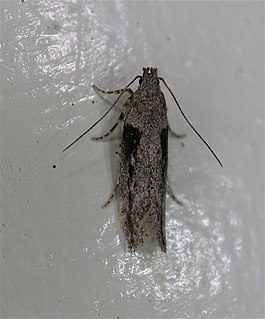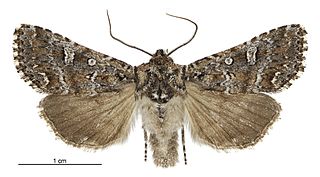
George Vernon Hudson FRSNZ was a British-born New Zealand entomologist. Hudson is credited with proposing the modern daylight saving time. He was awarded the Hector Memorial Medal in 1923.

Symmetrischema is a genus of moths in the family Gelechiidae.

Isophrictis striatella is a moth of the family Gelechiidae. It is found in most of Europe, as well as Turkey and North America.

Heterocrossa eriphylla, also known as the lichen snoutlet moth, is a species of moth in the family Carposinidae. It is endemic to New Zealand. The larvae of this species feed on the healing wounds of New Zealand beech trees.

Mary Esther Murtfeldt was an American entomologist, botanist, botanical collector, writer and editor. She undertook research on the life histories of insects, describing several species new to science and wrote extensively on entomology. Murtfeldt created a collection of plant specimens that contributed to the scientific knowledge on the plants of Missouri.

The parsnip moth or parsnip webworm is a moth of the family Depressariidae. It is found in most of Europe, except Portugal and most of the Balkan Peninsula. This species has also been introduced into New Zealand.

Ichneutica lithias is a moth of the family Noctuidae. This species is endemic to New Zealand. It is a small moth but distinctive as a result of the markings on its forewings. Although this species is widespread in the South Island, it has only been collected in the Rangipo Desert in the North Island. The species prefers habitat that is scrubland ranging in altitude from coastal to alpine. Adults are on the wing from October to April and larvae have been collected and reared on the New Zealand endemic plant species Melicytus alpinus.

Frechinia helianthiales is a moth in the family Crambidae. It was described by Mary Murtfeldt in 1897. It is found in North America, where it has been recorded from Arizona, Illinois, Manitoba, Missouri and Oklahoma, south to Mexico.
Epermenia pimpinella is a moth in the family Epermeniidae. It was described by Mary Murtfeldt in 1900. It is found in North America, where it has been recorded from South Carolina, Ohio, Illinois, Arkansas and Oklahoma.
Helcystogramma chambersella is a moth in the family Gelechiidae. It was described by Mary Murtfeldt in 1874. It is found in North America, where it has been recorded from Pennsylvania, Illinois, Ohio, South Carolina, Tennessee, Louisiana, Mississippi, Florida, Oklahoma, Missouri, Texas, Arizona and California.
Keiferia inconspicuella is a moth in the family Gelechiidae. It was described by Mary Murtfeldt in 1883. It is found in North America, where it has been recorded from the south-eastern and mid-western United States, north to New Jersey and Iowa and west to Nebraska and Texas.
Gnorimoschema alaricella is a moth in the family Gelechiidae. It was described by August Busck in 1908. It is found in North America, where it has been recorded from California, Kentucky, New Hampshire, Ohio and Pennsylvania.
Gnorimoschema gallaeasterella is a moth in the family Gelechiidae. It was described by D. S. Kellicott in 1878. It is found in North America, where it has been recorded from Alberta, California, Illinois, Kentucky, Maine, Maryland, New Hampshire, Oklahoma, Quebec and Tennessee.
Symmetrischema lectulifera is a moth in the family Gelechiidae. It was described by Edward Meyrick in 1929. It is found in North America, where it has been recorded Texas.
Symmetrischema fercularia is a moth in the family Gelechiidae. It was described by Edward Meyrick in 1929. It is found in North America, where it has been recorded Texas.
Symmetrischema capsica, the pepper flowerbud moth, is a moth in the family Gelechiidae. It was described by John David Bradley and Dalibor F. Povolný in 1965. It is found Mexico, the West Indies, the Caribbean and the south-eastern United States, where it has been recorded Florida and Texas.
Symmetrischema kendallorum is a moth in the family Gelechiidae. It was described by André Blanchard and Edward C. Knudson in 1982. It is found in North America, where it has been recorded Texas.
Symmetrischema lavernella is a moth in the family Gelechiidae. It was described by Vactor Tousey Chambers in 1874. It is found in North America, where it has been recorded Missouri, Texas, Illinois, Maine, Michigan, New Hampshire and the District of Columbia.
Symmetrischema pallidochrella is a moth in the family Gelechiidae. It was described by Vactor Tousey Chambers in 1872 and is found in North America.

Theoxena is a monotypic moth genus in the family Geometridae erected by Edward Meyrick in 1883. Its only species, Theoxena scissaria, was first described by Achille Guenée in 1868. It is endemic to New Zealand. This species has been classified as nationally vulnerable by the Department of Conservation.










